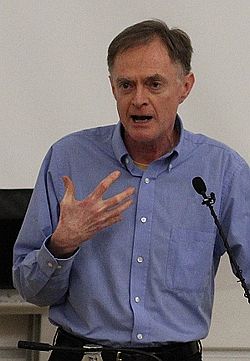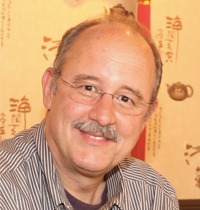For Better or For Worse
July 19, 2016
Author Richard Heinberg on new book Our Renewable Future: Laying the Path for One Hundred Percent Clean Energy on Radio Ecoshock. Plus plankton expert Dr. Michael Behrenfeld: is the foundation of ocean life in trouble? Radio Ecoshock 160629
Download or listen to this Radio Ecoshock show in Ecoshock 160629 Lo-Fi (14 MB) or Ecoshock 160629 CD Quality (56 MB)
************************************************
Richard Heinberg is known around the world as an energy expert. He’s a leader and Senior Fellow at the Post Carbon Institute, author of 13 books, and a returning guest on Radio Ecoshock. So when I got his newest book, written with David Fridley from the Berkeley Lab, I expected a triumphant plan for our transition to renewable energy in that post-carbon world. I was surprised, and we are all in for a big surprise, about how hard this change is going to be. It’s all in the new book Our Renewable Future: Laying the Path for One Hundred Percent Clean Energy published in June 2016. Richard Heinberg returns Radio Ecoshock.
I suppose I shouldn’t be shocked. Richard is are known for taking a hard doubtful look at things like oil reserves and coal industry hype. Now he and co-author Fridley dig into the realities of renewables. Just to be clear, David Fridley works at Berkeley Lab, which is part of the U.S. Department of Energy, although the lab is run by the University of California. Lately David has been a key advisor to the government of China about installing renewable energy there, which is being done on a colossal scale. Fridley speaks Mandarin.
MANY MOUNTAINS TO CLIMB FOR TRUE RENEWABLE ENERGY
The whole green-dreaming world felt empowered when Professor Mark Jacobson of Stanford wrote an article in Scientific American in 2009. Jacobson said we can make the switch to alternative energy by 2030. When I interviewed Mark in late 2014, he felt even more certain it’s all possible. I get Richard’s take on the Jacobson plan.
Essentially, Heinberg thinks Mark Jacobson spoke primarily about production, trying to reach levels we use today. Fridley and Heinberg find this may be unrealistic due to a large number of bottlenecks. Fossil fuels are used everywhere, not just to power cars. In this interview, we discuss cement production, which accounts for about 5% of global greenhouse emissions. Our civilization is literally built on concrete.
YOUR FOOD AND FOSSIL FUELS
But it doesn’t end there. Agriculture is the single largest user of fossil fuels, when you add it all up. We’re not just talking about the fuel used by tractors and farm implements. There’s the fertilizers (often made from natural gas), the pesticides and herbicides (usually refined oil products). THEN we refrigerate all kinds of foods, all the way to markets. Some of those markets are overseas, like fruit flown in. But wait, none of those are the biggest part of fossil fuels in the food chain. That comes with industrial food processing, all the machinery and chemicals used to make modern “food”. We talk it through, as Richard points out there are over 10 calories of fossil fuels in every calorie of mass market food!
Other products, like some pharmaceuticals and paints, currently have no known substitute without fossil fuels. These may be the last uses for oil or gas. Some people can’t keep living without them.
Yes we look at the problem of getting renewable energy to produce enough power to replace all those solar panels and wind machines when they expire in 20 or 30 years. Plus there is the sudden jolt of greenhouse gas emissions that will happen when we use fossil fuels to produce the first mass wave of real alternative energy.
Given all that, Heinberg and Fridley’s book goes beyond Jacobson, to look at the demand-side economics. We are going to have to live with less, if we want a climate we can live in.
THE BOOK: TRY IT BEFORE YOU BUY IT
While you may want Richard Heinberg the book to go over, and for reference, the authors think it’s so important they are also making it available free online! The entire book can be found for free at OurRenewableFuture.org There’s also a Facebook discussion Post Carbon Facebook .
Download or listen to this 24 minute Radio Ecoshock interview with Richard Heinberg in Heinberg CD Quality or Heinberg Lo-Fi
You can read Richard Heinberg’s famous long-running blog here at Heinberg his web site.
GIVING STUFF UP
I really wonder if masses of people are willing to reduce their carbon imprint, by giving stuff up, by staying close to home, and having fewer energy slaves. We seem so addicted to the powers fossil fuels give us, like the ability for some to fly anywhere in the world anytime, or for many to visit relatives more than a hundred miles away, or a single farmer to grow food on 1,000 acres with fossil machinery and chemicals. We have a thousand super powers. Who will give that up?
THE PROBLEM OF INTERMITTENCY
Critics complain about intermittent power when the sun doesn’t shine, or the wind doesn’t blow. For years, I have claimed civilization can cope with intermittent power. Hundreds of millions of people with uncertain electric supplies have done it for years (in Lagos, in India or wherever). We can run our washing machine when the sun or wind are available. I think we could even run factories and mass transit the same way. When power is available, the wheels of commerce turn. When it isn’t, we tend our gardens, our families and our lives.
************************************************


